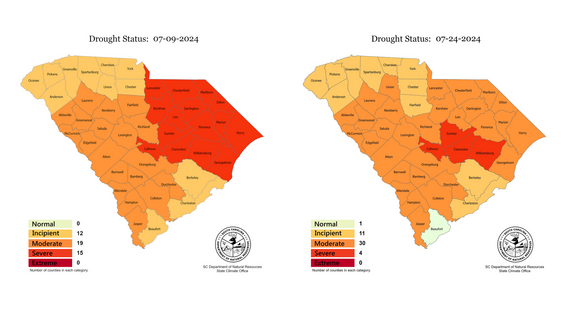Drought Status Downgraded for 13 Counties


The S.C. Drought Response Committee reconvened on July 24 to evaluate whether recent rains were enough to provide relief from the intensifying drought. The Committee upgraded the entire state on July 9 (see map). During today’s call the Committee downgraded 13 counties, upgraded one County and maintained the drought status for the remaining counties.
According to the Athena Strickland, Technical Services Manager with Domtar Paper and a committee member representing the northeast/Pee Dee Drought Management Area, “Significant rainfall across the Northeast Drought Management Area over the past two weeks have led to an improvement of many of the drought indicators. In the past two weeks most, areas have seen between 2-6 inches of rainfall with more indicated in the immediate forecast. While the Little Pee Dee and the Black Rivers have shown some recent increase in flow, they both remain extremely low, indicating the remaining effects from the extended dry period. The improvement of the Northeast Drought Management Area to moderate drought recognizes improvement with the increased rainfall, while still acknowledging the drought’s lingering effects.”
Reduced wildlife occurrence and improved streamflow were important factors in the Committee’s decision to downgrade the drought. Darryl Jones, Forest Protection Chief with the Forestry Commission reported, “We have been fortunate that the weather pattern in the last couple of weeks has changed, with lower temperatures and more thunderstorms across a lot of the state. While we still have a few areas that have high Keetch-Byram Drought Index numbers, the rain we have received combined with lower temperatures and higher relative humidity reduced fire danger in many areas. For the week ending on July 21 the Forestry Commission responded to 22 wildfires that burned just over 77 acres, so fire occurrence has been lower and much closer to normal levels.”
Hope Mizzell and Elliot Wickham with the SC State Climatology Office presented the drought indicators and rainfall data showing that many locations received more rain in the last two weeks than the previous five weeks combined. Both stressed while the recent rain has helped and the forecast looks encouraging, it could take weeks to months of normal rainfall to fully recover. They also showed that while the majority of the State received above normal rainfall since the July 9 committee meeting there are dry areas within counties that just keep missing the rain.
The committee heard from farmers and agriculture representatives emphasizing that for some farms and pastures the rain was too little and too late.
Sam Quinney, Agricultural Outreach Director for the SC Department of Agriculture explained that though recent rainfalls have been recorded in most areas across the state, Ag producers will still see a long impact from reduced yields. Row crop producers have been greatly affected in the production of one of SC’s major commodities, corn, due to drought and adverse heat effects. The combination of heat and drought came in during a crucial pollination period of corn production. Cattle producers are experiencing reduced production of warm season and perennial forages, causing them to seek alternative feed sources and reduce herd sizes to keep overall feed costs down. Other crop production such as soybean, cotton, and peanuts will possibly see reduced production leading to some below average yields. However recent rains give hope to certain producers to still make a crop on those commodities.
The committee is closely monitoring conditions statewide and will reconvene on August 13 to reevaluate the drought status.
